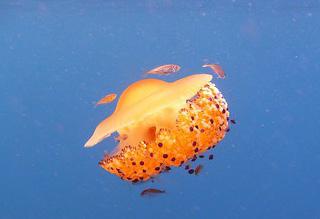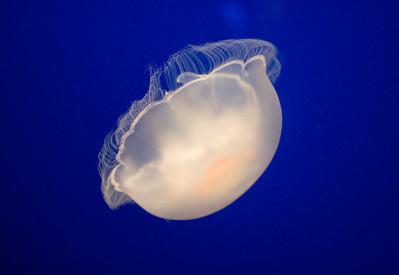
2 minute read
WHAT KIND OF JELLYFISH ARE
WHAT KIND OF JELLYFISH ARE YOU?
On a typical Saturday, you are:
Advertisement
A. Hanging out with some friends B. Watching Netflix C. Cooking D. Out on the town E. Hiking
Friends would describe you as: A. Laidback B. Shy C. Eccentric D. Lively E. Adventurous
At a party, you are:
A. On the fringes with some friends B. Ready to go home C. Meeting new people D. Wherever the action is E. Petting the dog Your wardrobe consists primarily of:
A. Comfortable clothes and loungewear B. Flowy fabric in neutral colors C. Unusual statement pieces D. Bright colors and fun prints E. Floral patterns and earth tones

Pick your favorite word: A. Quiescent B. Ethereal C. Perplexing D. Gargantuan E. Luminescent
Mostly A: Congratulations! You are Cassiopeia xamachana, or the upside-down jellyfish! Commonly found hanging out in groups in shallow tropical waters and mangrove forests, these jellies use their bells like a suction cup to lie upside down in order to let the algae living in their tissues photosynthesize. Upside-down jellyfish feed on the nutrients provided by these algae, as well as on zooplankton.

Mostly E: Congratulations! You are Olindias formosus, or the flower hat jellyfish! These rare jellyfish live in coastal waters and sometimes hang out on the seafloor, where they feed on small fishes. Their multicolored tentacles can rapidly coil and uncoil, and have fluorescent tips.

Mostly C: Congratulations! You are Phacellophora camtschatica, or the fried egg jellyfish! Also called the egg-yolk jellyfish, they live in temperate open waters. These unique creatures can reach a diameter of up to 2 feet, and use their long tentacles to catch other jellies. Additionally, fried egg jellyfish often play host to small crabs, fish, and amphipods, which hitch a ride inside their bells.

Mostly B: Congratulations! You are Aurelia aurita, or the moon jelly! These translucent organisms live in temperate or tropical waters, feeding by drawing food to the short cilia lining their bells. Moon jellies can change color depending on what they’ve been eating; for example, one that has been eating lots ofshrimp may turn orange!


Mostly D: Congratulations! You are Cyanea capillata, or the lion’s mane jellyfish! Named for the mass oftentacles hanging under their bells, these gigantic jellies can grow up to 120 feet long, making them the largest jellyfish in the world, and challengers of the blue whale in terms oflength! Lion’s mane jellyfish live in cool waters, where they feed on small fish and crustaceans.










